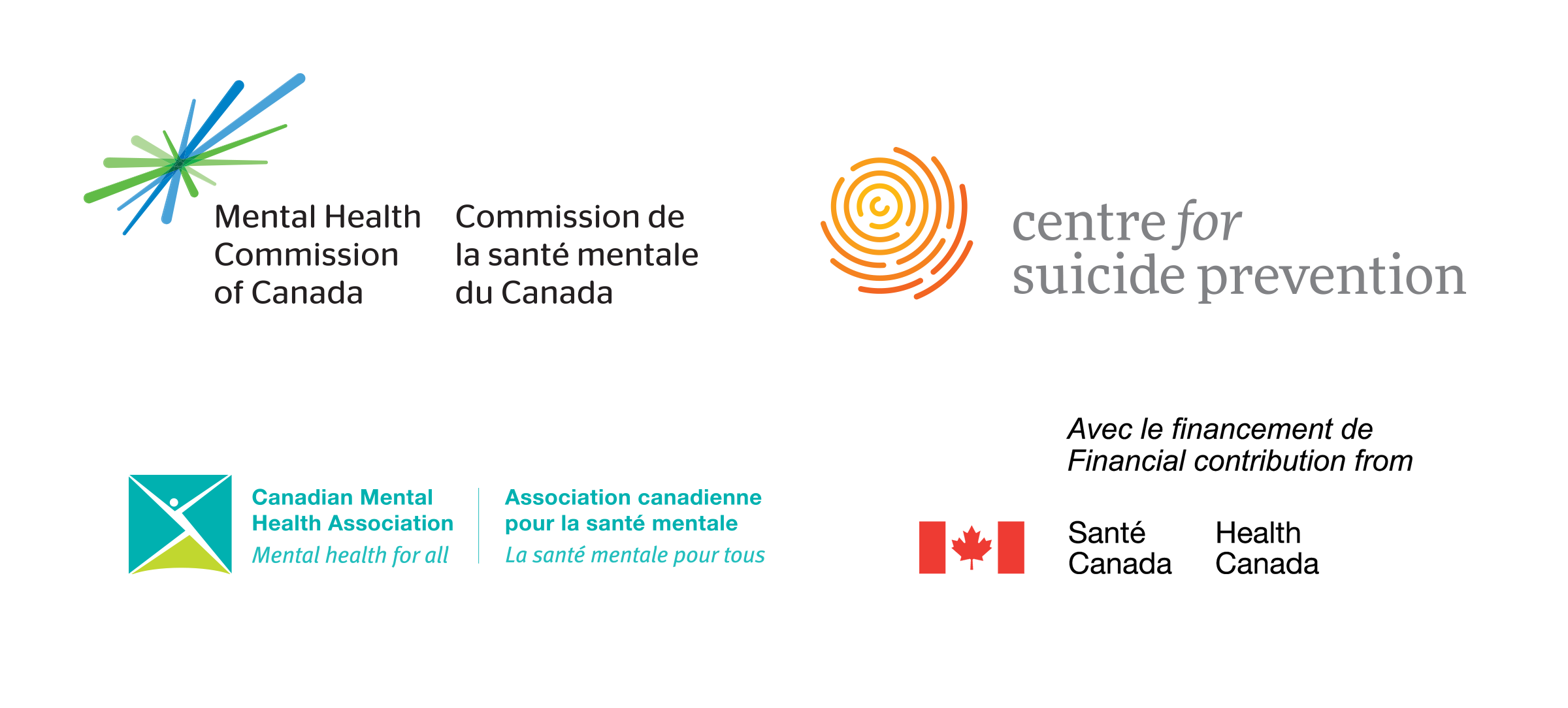Transgender people and suicide
CENTRE FOR SUICIDE PREVENTION, MENTAL HEALTH COMMISSION OF CANADA, CANADIAN ASSOCIATION FOR SUICIDE PREVENTION
Cliquez ici pour la version française
Click here to view all our fact sheets on suicide.
These fact sheets are a collaboration between the Centre for Suicide Prevention and the Mental Health Commission of Canada.
Transgender (trans) people face unique stressors, including the stress some trans people experience when their gender identity is not affirmed. Trans people also experience higher rates of discrimination and harassment than their cisgender counterparts and, as a result, experience poorer mental health outcomes. They are also at a greater risk for suicide as they are twice as likely to think about and attempt suicide than LGB people (Haas et al., 2011; McNeill et al., 2017; Irwin et al., 2014).
Gender identity refers to a personal conception of one’s place on the gender spectrum; the gender that one identifies as may be the same or different from their birth assigned sex.
Transgender (trans) is an umbrella term that represents a wide range of gender identities and expressions. Trans people do not identify either fully or partially with the gender associated with their assigned sex at birth (Canadian Federation of Students, 2017).
Statistics
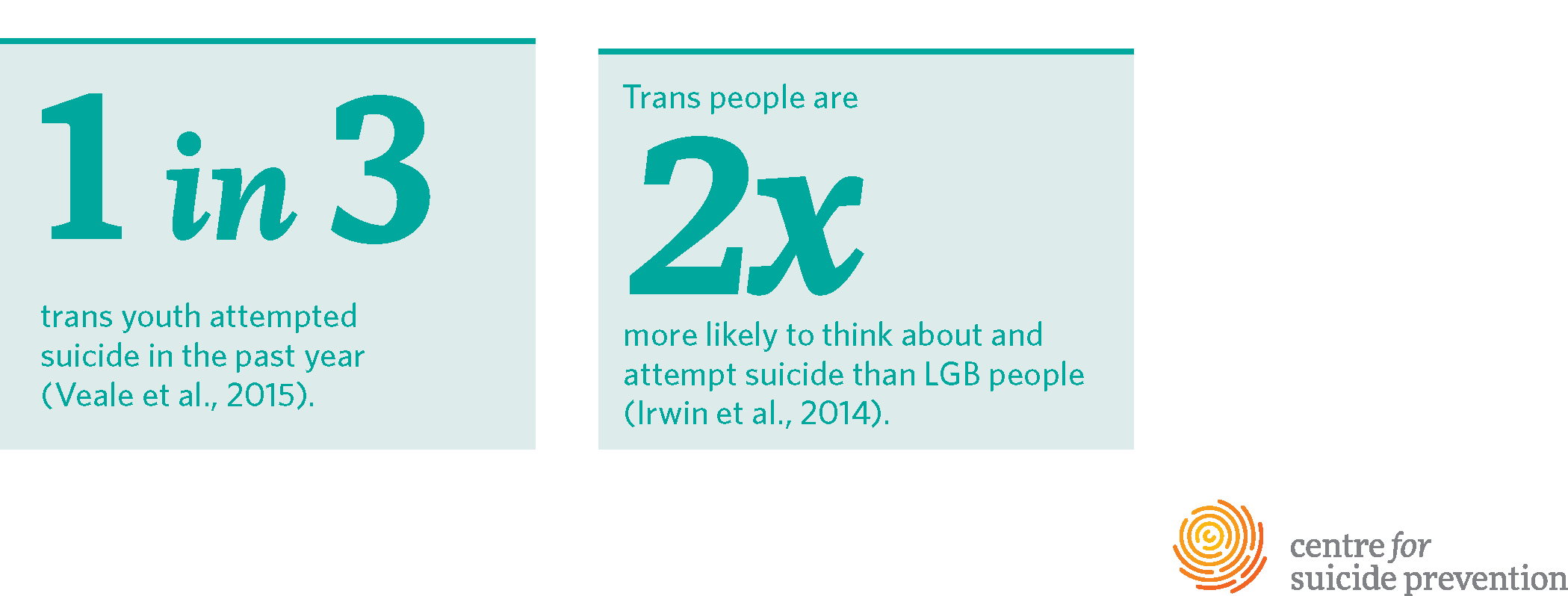
Why are trans people at risk?
There are a few factors that put transgender people at risk of suicide, factors that can put strain on one’s mental health and potentially lead to thoughts of suicide:
- Institutional prejudice manifesting as laws and policies which create inequalities and/or fail to provide protection from discrimination
- Experience of discrimination (transphobia) in the form of physical or verbal harassment, physical or sexual assault
- Lack of support from parents and other family members
- Stress related to fear of transitioning, including the potential backlash and life disruption, as well as considering the risks and sometimes lengthy time period involved
- Gender dysphoria, or distress related to a conflict between one’s physical or assigned gender and the gender with which they identify
(Bailey et al., 2014; Haas et al., 2011; Suicide Prevention Resource Center [SPRC], 2008; Taylor et al., 2011).
What can reduce risk?
- Supportive and strong relationships with family and friends
- Completed medical transition (if medical transition is desired)
- Self-awareness and acceptance
- Access to gender affirming health care
- Not having access to lethal means such as guns or potentially deadly medications
- Having one’s name and pronouns accepted
(Bailey et al., 2014; Bauer et al., 2015a; Haas et al., 2011; SPRC, 2008).
Warning signs
Any significant change in behaviour or mood is a warning sign that someone may be thinking about suicide, for example:
- Losing interest in a previously enjoyed hobby or activity
- Disconnecting from friends or family (not calling as much, not going out)
- Change in sleeping or eating patterns
- Increased and excessive drug and/or alcohol use
If you notice any of the following signs, get the person help immediately – call 9-1-1 or your local crisis centre:
- Threatening to hurt or kill themselves
- Talking or writing about dying or suicide
- Seeking out ways to kill themselves (American Association of Suicidology, 2018)
What can we all do to help reduce suicide among trans people?
If someone you know is exhibiting warning signs, have an open, non-judgmental conversation with them. You can start the conversation by mentioning your concerns, “You seem to be having a lot of family issues lately. How are you doing?” Listen to them, be there for them. You don’t have to offer solutions. If the person responds with statements of hopelessness or being a burden, ask them about those feelings. Then, ask them directly, “Are you thinking about killing yourself?”
(Substance Abuse and Mental Health Services Administration, 2010)
Ensure trans people feel respected by affirming their gender identification. Use their chosen name and pronouns, as well as sensitive and inclusive language. If you’re not sure what terms to use, listen to how they refer to themselves, or ask! (Russell et al., 2018)
The wellbeing of trans people can be greatly affected by the characteristics, norms, practices, and spaces of institutional environments.
- Schools should implement safe-school policies and procedures specifically addressing transphobia (Saewyc, 2014).
- Health care practitioners should be trained in gender diversity and trans health, as trans people often require specialized care (Veale et al., 2015). A survey from TransPulse of transgender persons found that half reported discomfort discussing trans health issues with a physician and that 38% had at least one trans-specific negative experience (Bauer et al., 2015a).
- Parents and family members of trans people should be accepting and supportive (Bauer et al., 2015b).
- All institutions should ensure that trans people have access to bathrooms and gender-appropriate campus housing (Seelman, 2016).
67% of transitioning people thought more about suicide before transitioning whereas only 3% thought about suicide more after their transition (Bailey et al., 2014).
What can trans people do to stay mentally healthy?
- Consider how to transition.
Decide whether to transition in appearance and by name, and if a medical transition is desired, too. - Prioritize positive relationships.
Call, text, and hang out with supportive and affirming friends and family members and consider reaching out to other trans people, especially peers. - Find an inclusive and affirming healthcare provider.
This is vital to ensure safety and comfort when accessing healthcare services. - Ask for help when it is needed!
When struggling to cope with life, tell a loved one or call the local crisis line, or the Trans Lifeline at 877-330-6366.
Resource
The Genderbread Person by It’s Pronounced Metrosexual http://itspronouncedmetrosexual.com/2018/10/the-genderbread-person-v4/#
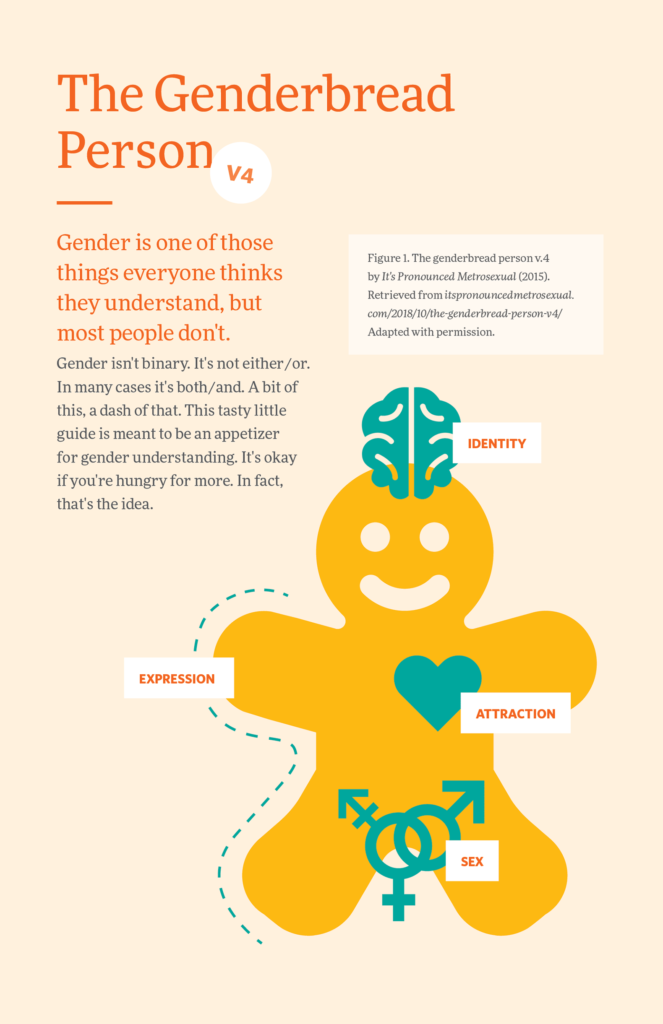
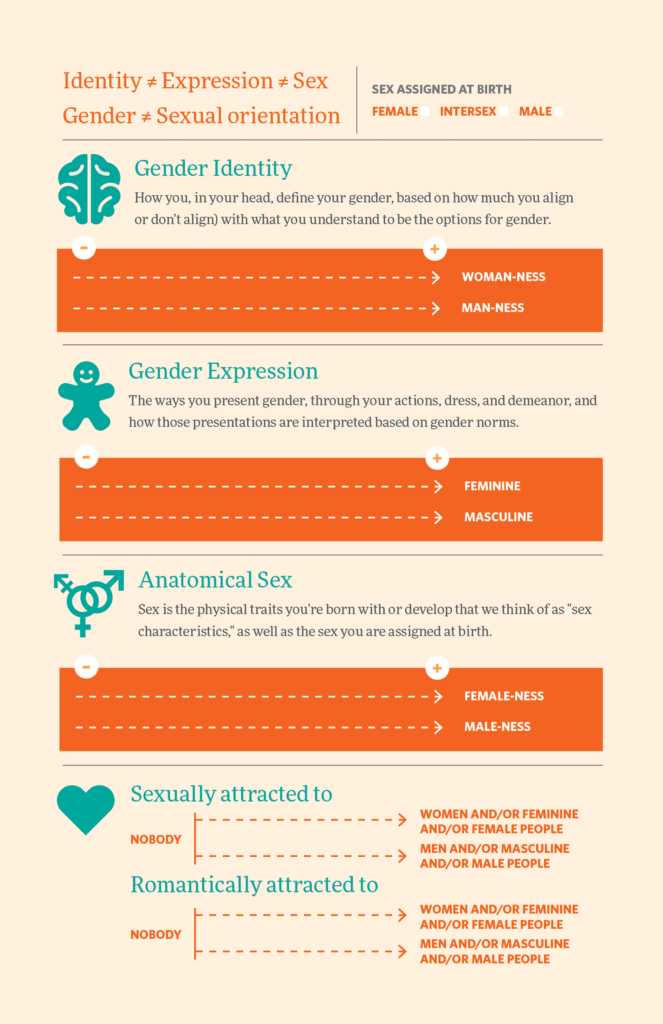
Source: It’s Pronounced Metrosexual
If you’re interested in learning more on transgender people and suicide, check out our toolkit.
References
American Association of Suicidology. (2018). Know the Warning Signs of Suicide. Retrieved from http://www.suicidology.org/resources/warning-signs
Bailey, L., Ellis, S., & McNeil, J. (2014). Suicide risk in the UK trans population and the role of gender transitioning in decreasing suicidal ideation and suicide attempt. Mental Health Review Journal, 19(4), 209-220. http://doi.org/10.1108/MHRJ-05-2014-0015
Bauer, G., Zong, X., Scheim, A., Hammond, R. & Thind, A. (2015a). Factors impacting transgender patients discomfort with their family physicians: A respondent-driven sampling study. PloSONE 2015; 10(12): e0145046. https://doi.org/10.1371/journal.pone.0145046
Bauer, G., Schiem, A., Travers, R. & Hammond, R. (2015b). Intervenable factors associated with suicide risk in transgender persons: A respondent driven suicide risk sampling study in Ontario, Canada. BMC Public Health. DOI: 10.1186/s12889-015-1867-2. http://doi.org/10.1186/s12889-015-1867-2
Haas, A., Eliason, M., Mays, V., Mathy, R., Cochran, S., D’Augelli, A., Silverman, M., Fisher, P., Hughes, T., Rosario, M., Russell, S., Malley, E., Reed, J., Litts, D.A., Haller, E., Sell, R.L., Remafed, G., Bradford, J., Beautrais, A.L., Brown, G.K., Diamond, G.M., Friedman, M.S., Farofalo, R., Turner, M.S., Hollibaugh, A. & Clayton, P. (2011). Suicide and suicide risk in lesbian, gay, bisexual and transgender populations: Review and recommendations. Journal of Homosexuality, 58(1),10-51. https://doi.org/10.1080/00918369.2011.534038
Irwin, J., Coleman, J., Fisher, C. & Marasco, V. (2014). Correlates of suicide ideation among LGBT Nebraskans. Journal of Homosexuality, 61(8), 1172-1191. https://doi.org/10.1080/00918369.2014.872521
McNeill, J., Ellis, S. & Eccles, S. (2017). Suicide in trans populations: A systematic review of prevalence and correlates. Psychology of Sexual Orientation. http://doi.org/10.1037/sgd0000235
National LGBTI Health Alliance. (2016). National lesbian, gay, bisexual, transgender and intersex mental health and suicide prevention strategy: A new strategy for inclusion and action. Retrieved from https://lgbtihealth.org.au/wp-content/uploads/2016/12/LGBTI_Report_MentalHealthandSuicidePrevention_Final_Low-Res-WEB.pdf
Russell, S., Pollitt, A., Li, G. & Grossman, A. (2018). Chosen name is linked to reduced depressive symptoms, suicidal ideation, and suicidal behavior among transgender youth. Journal of Adolescent Health. https://doi.org/10.1016/j.jadohealth.2018.02.003
Saewyc, E., Konishi, C., Rose, H., & Homma, Y. (2014). School-based strategies to reduce suicidal ideation, suicide attempts and discrimination among sexual minority and heterosexual adolescents in western Canada. International Journal of Child and Youth Family Studies, 5(1), 89-112. https://doi.org/10.18357/ijcyfs.saewyce.512014
Seelman, K., Colon-Diaz, M.,LeCroix, R., Xavier-Brier, M. & Kattari, L. (2017). Transgender noninclusive healthcare and delaying care because of fear: Connections to general health and mental health among transgender adults. Transgender Health, 2(1). https://doi.org/10.1089/trgh.2016.0024
Seelman, K. (2016). Transgender adults’ access to college bathrooms and housing and the relationship to suicidality. Journal of Homosexuality, 63(10), 1378-1399. https://doi.org/10.1080/00918369.2016.1157998
Substance Abuse and Mental Health Services Administration. (2010). It takes a community: Report on the summit on opportunities for mental health promotion and suicide prevention in senior living communities. Retrieved from http://www.sprc.org/resources-programs/it-takes-community-report-summit-opportunities-mental-health-promotion-suicide
Suicide Prevention Resource Center. (2008). Suicide risk and prevention in gay, lesbian, bisexual and transgender youth. Newton, MA: Education Development Center, Inc. Retrieved from http://www.sprc.org/sites/default/files/migrate/library/SPRC_LGBT_Youth.pdf
Taylor, C., Peter, T., McMinn, T. L., Elliott, T., Beldom, S., Ferry, A., et al. (2011). Every class in every school: The first national climate survey on homophobia, biphobia, and transphobia in Canadian schools. Final report. Toronto: Egale Canada Human Rights Trust. Retrieved from https://egale.ca/wp-content/uploads/2011/05/EgaleFinalReport-web.pdf
Veale, J., Watson, R., Peter, T., & Saewyc, E. (2016). Mental health disparities among Canadian transgender youth. Journal of Adolescent Health, 60(1), 44-49. http://doi.org/10.1016/j.jadohealth.2016.09.014
Veale, J., Saewyc, E., Frohard-Dourlent, H., Dobson, S., Clark, B. & the Canadian Trans Youth Health Survey Research Group. (2015). Being safe, being me: Results of the Canadian trans youth health survey. Vancouver, BC: Stigma and Resilience Among Vulnerable Youth Centre, School of Nursing, University of British Columbia. Retrieved from https://saravyc.sites.olt.ubc.ca/files/2015/05/SARAVYC_Trans-Youth-Health-Report_EN_Final_Web2.pdf
Les personnes transgenres et le suicide
Les personnes transgenres (trans) font face à des facteurs de stress particuliers, comme le stress ressenti lorsque leur identité de genre n’est pas affirmée. Les personnes transgenres subissent également des incidences plus élevées de discrimination et de harcèlement que leurs homologues cisgenres et, par conséquent, ont une moins bonne santé mentale. Elles sont également plus à risque de se suicider, car elles sont deux fois plus susceptibles de songer au suicide et de faire une tentative de suicide que les personnes LGB (Haas et coll., 2011; McNeill et coll., 2017; Irwin et coll., 2014).
Identité de genre fait référence à la conception personnelle de sa place sur le continuum de l’identité sexuelle; le genre auquel on s’identifie peut être le même que celui attribué à la naissance, ou être différent.
Transgenre (trans) est un terme générique qui englobe un large éventail d’identités sexuelles et d’expressions de genre. Les personnes transgenres ne s’identifient pas entièrement, ou ne s’identifient que partiellement, au sexe associé au genre qui leur a été attribué à la naissance (Fédération canadienne des étudiantes et étudiants, 2017).
Statistiques
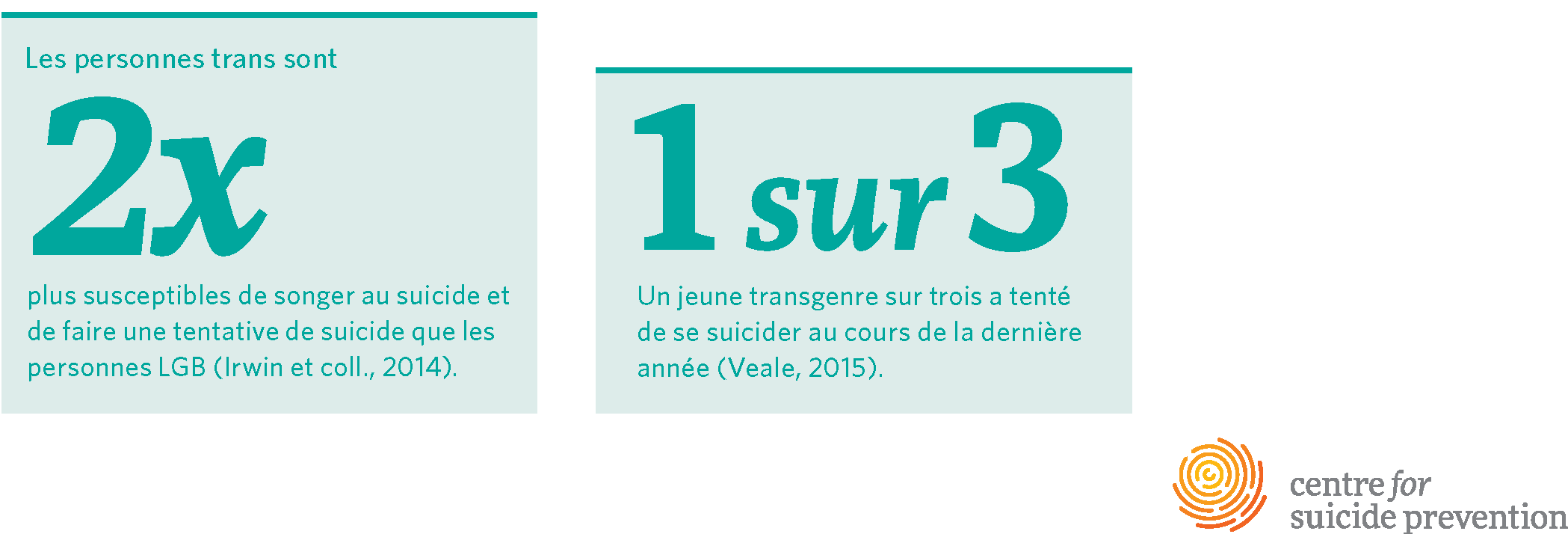
Pourquoi les personnes trans sont-elles à risque?
Certains facteurs exposent les personnes transgenres au risque de suicide, nuisent à leur santé mentale et peuvent éventuellement donner lieu à des idées suicidaires :
- Préjudice institutionnel qui se manifeste par le biais des lois et des politiques qui créent des inégalités et (ou) qui n’offrent aucune protection contre la discrimination
- Expérience de discrimination (transphobie) sous forme de harcèlement physique ou verbal, d’agression physique ou sexuelle
- Manque de soutien de la part des parents et des autres membres de la famille
- Stress lié à la peur de la transition, notamment les réactions négatives et les perturbations de la vie, ainsi que la prise en considération des risques associés aux interventions médicales et de la période de rétablissement parfois longue
- Dysphorie de genre ou la détresse causée par la contradiction vécue entre le genre physique ou attribué et le genre avec lequel la personne s’identifie
(Bailey et coll., 2014; Haas et coll., 2011; Suicide Prevention Resource Center [SPRC], 2008; Taylor et coll., 2011).
Qu’est-ce qui peut contribuer à réduire les risques?
- Relations solides avec la famille et les amis qui offrent des liens de soutien
- Transition médicale complétée (si cette transition est souhaitée)
- Conscience de soi et acceptation
- Accès à des soins de santé offrant la réassignation sexuelle
- Ne pas avoir accès à des moyens de s’enlever la vie, tels que des armes à feu ou des médicaments potentiellement mortels
- Acceptation de son nom et des pronoms associés à la nouvelle identité
(Bailey et coll., 2014; Bauer et coll., 2015a; Haas et coll., 2011; SPRC, 2008).
Signes précurseurs
Tout changement important dans le comportement ou l’humeur d’une personne pourrait être un signe avant-coureur de suicide. Voici quelques exemples de signes associés au suicide :
- Désintérêt pour un passe-temps ou une activité qui était synonyme de plaisir avant
- Perte de contact avec ses amis ou sa famille (ne pas appeler autant qu’avant, ne pas sortir)
- Changement des habitudes alimentaires ou de sommeil
- Augmentation de la consommation de drogues et (ou) d’alcool, et abus
Si vous remarquez un des signes de détresse suivants chez quelqu’un, portez-lui immédiatement secours en appelant le 9-1-1 ou en communiquant avec le centre local de soutien en cas de crise :
- Menacer de se blesser ou de se suicider
- Parler ou écrire au sujet de la mort ou du suicide
- Chercher des moyens de se suicider (American Association of Suicidology, 2018)
Que pouvons-nous tous faire pour réduire le risque de suicide chez les personnes trans?
Si vous connaissez quelqu’un qui présente des signes avant-coureurs de suicide, discutez ouvertement avec lui, sans porter de jugement. Vous pouvez commencer la conversation en lui faisant part de vos inquiétudes : « Tu sembles avoir beaucoup de problèmes avec ta famille récemment. Est-ce que ça va? » Écoutez la personne, soyez là pour elle. Vous n’avez pas à lui proposer de solutions. Si la personne semble découragée ou qu’elle a l’impression d’être un fardeau pour son entourage, interrogez-la sur ces sentiments. Puis, posez-lui la question suivante directement : « Est-ce que tu penses au suicide? »
(Substance Abuse and Mental Health Services Administration, 2010).
Assurez-vous que les personnes trans se sentent respectées lorsqu’elles affirment leur identité sexuelle. Utilisez le nom et les pronoms choisis, ainsi qu’un langage adapté et inclusif. Si vous n’êtes pas certain des termes à utiliser, portez attention aux termes que la personne utilise ou demandez-lui tout simplement. (Russell et coll., 2018)
Le bien-être des personnes transgenres peut être grandement affecté par les caractéristiques, les normes, les pratiques et les espaces des milieux institutionnels.
- Les écoles devraient mettre en œuvre des politiques et des procédures de sécurité visant à lutter expressément contre la transphobie (Saewyc, 2014).
- Les professionnels de la santé devraient recevoir une formation sur la diversité des sexes et la santé des personnes trans, puisque celles-ci requièrent souvent des soins spécialisés (Veale et coll., 2015). L’enquête TransPulse a révélé que la moitié des répondants transgenres avouaient être mal à l’aise de discuter de problèmes de santé trans avec un médecin, et que 38 % avaient vécu au moins une expérience négative liée à leur identité transgenre (Bauer et coll., 2015a).
- Les parents et les membres de la famille des personnes trans devraient les accepter pleinement et se montrer solidaires (Bauer et coll., 2015b).
- Toutes les institutions devraient faire en sorte que les personnes transgenres aient accès à des salles de bains et à des logements sur le campus qui sont adaptés au genre (Seelman, 2016).
Que peuvent faire les personnes trans pour rester en bonne santé mentale?
- Considérer comment faire la transition.
La décision de commencer un processus de transition est personnelle. La transition peut comporter une combinaison d’éléments sociaux, physiques, médicaux et juridiques. - Prioriser les relations positives.
Il est important de téléphoner, d’envoyer des textos et de passer du temps avec les amis et les membres de la famille qui offrent leur soutien. Songer à tendre la main à d’autres personnes transgenres, en particulier des pairs. - Trouver un fournisseur de soins de santé inclusif et ouvert à la réassignation sexuelle.
Ceci est essentiel pour assurer la sécurité et le confort lors de l’accès aux services de soins de santé.
- Aller chercher de l’aide en cas de besoin!
Lorsque les difficultés de la vie semblent insurmontables, il faut en parler à un proche, appeler la ligne locale d’écoute téléphonique, ou encore la Trans Lifeline au : 877-330-6366.
Ressource
The Genderbread Person par It’s Pronounced Metrosexual http://itspronouncedmetrosexual.com/2018/10/the-genderbread-person-v4/#
Références
American Association of Suicidology. (2018). Know the warning signs of suicide. Extrait du site http://www.suicidology.org/resources/warning-signs
Bailey, L., Ellis, S., et McNeil, J. (2014). Suicide risk in the UK trans population and the role of gender transitioning in decreasing suicidal ideation and suicide attempt. Mental Health Review Journal, 19(4), pages 209 à 220. http://doi.org/10.1108/MHRJ-05-2014-0015
Bauer, G., Zong, X., Scheim, A., Hammond, R. et Thind, A. (2015a). Factors impacting transgender patients discomfort with their family physicians: A respondent-driven sampling study. PloSONE 2015; 10(12): e0145046. https://doi.org/10.1371/journal.pone.0145046
Bauer, G., Schiem, A., Travers, R. et Hammond, R. (2015b). Intervenable factors associated with suicide risk in transgender persons: A respondent driven suicide risk sampling study in Ontario, Canada. BMC Public Health. DOI : 10.1186/s12889-015-1867-2 http://doi.org/10.1186/s12889-015-1867-2
Fédération canadienne des étudiantes et étudiants (2017). Defining terms and expanding our understanding: Working toward gender inclusive spaces. Consulté à l’adresse http://cfsontario.ca/wp-content/uploads/2017/07/DefiningTerms.pdf
Haas, A., Eliason, M., Mays, V., Mathy, R., Cochran, S., D’Augelli, A., Silverman, M., Fisher, P., Hughes, T., Rosario, M., Russell, S., Malley, E., Reed, J., Litts, D.A., Haller, E., Sell, R.L., Remafed, G., Bradford, J., Beautrais, A.L., Brown, G.K., Diamond, G.M., Friedman, M.S., Farofalo, R., Turner, M.S., Hollibaugh, A. et Clayton, P. (2011). Suicide and suicide risk in lesbian, gay, bisexual and transgender populations: Review and recommendations. Journal of Homosexuality, 58(1), pages 10 à 51. https://doi.org/10.1080/00918369.2011.534038
Irwin, J., Coleman, J., Fisher, C. et Marasco, V. (2014). Correlates of suicide ideation among LGBT Nebraskans. Journal of Homosexuality, 61(8), pages 1172 à 1191. https://doi.org/10.1080/00918369.2014.872521
McNeill, J., Ellis, S. et Eccles, S. (2017). Suicide in trans populations: A systematic review of prevalence and correlates. Psychology of Sexual Orientation. http://doi.org/10.1037/sgd0000235
National LGBTI Health Alliance. (2016). National lesbian, gay, bisexual, transgender and intersex mental health and suicide prevention strategy: A new strategy for inclusion and action. Consulté à l’adresse https://lgbtihealth.org.au/wp-content/uploads/2016/12/LGBTI_Report_MentalHealthandSuicidePrevention_Final_Low-Res-WEB.pdf
Russell, S., Pollitt, A., Li, G. et Grossman, A. (2018). Chosen name is linked to reduced depressive symptoms, suicidal ideation, and suicidal behavior among transgender youth. Journal of Adolescent Health. https://doi.org/10.1016/j.jadohealth.2018.02.003
Saewyc, E., Konishi, C., Rose, H., et Homma, Y. (2014). School-based strategies to reduce suicidal ideation, suicide attempts and discrimination among sexual minority and heterosexual adolescents in western Canada. International Journal of Child and Youth Family Studies, 5(1), pages 89 à 112. https://doi.org/10.18357/ijcyfs.saewyce.512014
Seelman, K., Colon-Diaz, M., LeCroix, R., Xavier-Brier, M. et Kattari, L. (2017). Transgender noninclusive healthcare and delaying care because of fear: Connections to general health and mental health among transgender adults. Transgender Health, 2(1). https://doi.org/10.1089/trgh.2016.0024
Seelman, K. (2016). Transgender adults’ access to college bathrooms and housing and the relationship to suicidality. Journal of Homosexuality, 63(10), pages 1378 à 1399. https://doi.org/10.1080/00918369.2016.1157998
Substance Abuse and Mental Health Services Administration. (2010). It takes a community: Report on the summit on opportunities for mental health promotion and suicide prevention in senior living communities. Extrait du site http://www.sprc.org/resources-programs/it-takes-community-report-summit-opportunities-mental-health-promotion-suicide
Suicide Prevention Resource Center. (2008). Suicide risk and prevention in gay, lesbian, bisexual and transgender youth. Newton, Massachusetts : Education Development Center, Inc. Consulté à l’adresse http://www.sprc.org/sites/default/files/migrate/library/SPRC_LGBT_Youth.pdf
Taylor, C., Peter, T., McMinn, T. L., Elliott, T., Beldom, S., Ferry, A., et coll. (2011). Every class in every school: The first national climate survey on homophobia, biphobia, and transphobia in
Canadian schools. Final report. Toronto : Egale Canada Human Rights Trust. Consulté à l’adresse https://egale.ca/wp-content/uploads/2011/05/EgaleFinalReport-web.pdf
Veale, J., Watson, R., Peter, T., et Saewyc, E. (2016). Mental health disparities among Canadian transgender youth. Journal of Adolescent Health, 60(1), pages 44 à 49. http://doi.org/10.1016/j.jadohealth.2016.09.014
Veale, J., Saewyc, E., Frohard-Dourlent, H., Dobson, S., Clark, B. et le Canadian Trans Youth Health Survey Research Group. (2015). Being safe, being me: Results of the Canadian trans youth health survey. Vancouver (C.-B.) : Stigma and Resilience Among Vulnerable Youth Centre, School of Nursing, Université de la Colombie-Britannique. Consulté à l’adresse https://saravyc.sites.olt.ubc.ca/files/2015/05/SARAVYC_Trans-Youth-Health-Report_EN_Final_Web2.pdf
À propos du Centre for Suicide Prevention
Tout le monde peut apprendre à reconnaître une personne à risque de se suicider et lui trouver de l’aide. Appelez-nous. Nous sommes le Centre for Suicide Prevention, une branche de l’Association canadienne pour la santé mentale. Depuis plus de 35 ans, nous fournissons à la population canadienne les connaissances et les compétences requises pour intervenir auprès de personnes à risque de se suicider. Nous pouvons vous procurer les bons outils. Une éducation pour la vie.
À propos de la Commission de la santé mentale du Canada
La Commission de la santé mentale du Canada (CSMC) joue un rôle catalyseur dans l’amélioration du système de santé mentale et la transformation des attitudes et des comportements de la population canadienne à l’égard des problèmes de santé mentale.
Si vous êtes en crise, appelez la ligne d’écoute téléphonique de votre région.
